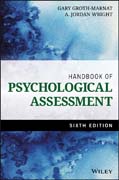
Organized according to the sequence mental health professionals follow when conducting an assessment, this classic resource covers principles of assessment, evaluation, referral, treatment planning, and report writing. Written in a practical, skills–based manner, the sixth editionprovides guidance on the most efficient methods for selecting and administering tests, interpreting assessment data, how to integrate test scores and develop treatment plans as well as instruction on ways to write effective, client–oriented psychological reports. The latest edition provides through coverage of the most commonly used assessment instruments including the Wechsler Intelligence Scales, Wechsler Memory Scales, Minnesota Multiphasic Personality Inventory, Personality Assessment Inventory, Millon Clinical Multiaxial Inventory, NEO Personality Inventory, Rorschach, Thematic Apperception Test, and brief assessment instruments for treatment planning, monitoring, and outcome assessment. In addition, this sixth edition includes: Fully updated with new research and the DSM–5 and ICD–10 New chapter on the NEO Personality Inventory–3. The NEO inventories provide a comprehensive assessment of adult and adolescent personality based on the strongly empirically supported Five Factor Model of personality. New chapter on the Personality Assessment Inventory (PAI), which has gained both strong empirical support and wide clinical popularity. Includes updated information on the newly developed Wechsler Intelligence Scale for Children, Fifth Edition (WISC–V). The chapter on the Minnesota Multiphasic Personality Inventory includes coverage of both the MMPI–2 and the MMPI–2–Restructured Form (MMPI–2–RF) The chapter on the Rorschach discusses both the Comprehensive System and the Rorschach Performance Assessment System (R–PAS). The Use with Diverse Groups sections reflect the more extensive use of assessment for a wide variety of populations and the importance of competently and sensitively working with diverse populations. Greater emphasis on making assessment more user friendly and consumer oriented. This is reflected in suggestions for using everyday language in reports, connecting interpretations to actual client behavior, strategies for wording interpretations in a manner likely to enhance client growth, and the importance of collaborating with clients. The treatment planning and clinical decision making chapter has been completely updated, and the psychological report writing chapter has been updated to include the American Psychological Association and Society for Personality Assessment s current thinking about proficiency in personality assessment. INDICE: Preface .Chapter 1 Introduction .Organization of the Handbook .Role of the Clinician .Patterns of Test Usage in Clinical Assessment .Evaluating Psychological Tests .Validity in Clinical Practice .Clinical Judgment .Phases in Clinical Assessment .Recommended Reading .Chapter 2 Context of Clinical Assessment .Types of Referral Settings .Ethical Practice of Assessment .Assessing Diverse Groups .Selecting Psychological Tests .Computer–Assisted Assessment .Recommended Reading .Chapter 3 The Assessment Interview .History and Development .Issues Related to Reliability and Validity .Assets and Limitations .The Assessment Interview and Case History .Mental Status Evaluation .Interpreting Interview Data .Structured Interviews .Recommended Reading .Chapter 4 Behavioral Assessment .History and Development .Issues Related to Reliability and Validity .Assets and Limitations .Strategies of Behavioral Assessment .Recommended Reading .Chapter 5 Wechsler Intelligence Scales .Testing of Intelligence: Pros and Cons .History and Development .Reliability and Validity .Assets and Limitations .Use with Diverse Groups .Meaning of IQ Scores .Cautions and Guidelines in Administration .WAIS–IV/WISC–V Successive–Level Interpretation Procedure .Wechsler Indexes and Subtests .Assessing Brain Damage .Assessing Additional Special Populations .Short Forms .Recommended Reading .Chapter 6 Wechsler Memory Scales .History and Development .Reliability and Validity .Assets and Limitations .Use with Diverse Groups .Interpretation Procedure .Interpreting Patterns of Index Scores .Comparing Scores on the WAIS–IV and the WMS–IV .Additional Considerations: Malingering and Evaluating Change .Recommended Reading .Chapter 7 Minnesota Multiphasic Personality Inventory .History and Development .Reliability and Validity .Assets and Limitations .Use with Diverse Groups .Administration .MMPI–2 Interpretation Procedure .MMPI–2 Computerized Interpretation .MMPI–2 Validity Scales .MMPI–2 Clinical Scales .MMPI–2 2–Point Codes .MMPI–2 Content Scales .MMPI–A Content Scales .MMPI–2 Harris–Lingoes and Si Subscales .MMPI–2 Critical Items .MMPI–2 and MMPI–A Supplementary Scales .MMPI–2–RF Interpretation Procedure .MMPI–2–RF Validity Scales .MMPI–2–RF Higher–Order Scales .MMPI–2–RF Restructured Clinical Scales .MMPI–2–RF Specific Problem Scales .MMPI–2–RF Personality Psychopathology Five Scales (PSY–5) .Recommended Reading .Chapter 8 Personality Assessment Inventory .History and Development .Reliability and Validity .Assets and Limitations .Use with Diverse Groups .Interpretation Procedure .Validity Scales .Clinical Scales .Treatment Scales .Interpersonal Scales .Additional Clusters .Critical Items .Recommended Reading .Chapter 9 Millon Clinical Multiaxial Inventory .History and Development .Reliability and Validity .Assets and Limitations .Use with Diverse Groups .Interpretation Procedure .Validity Scales .Clinical Personality Patterns .Severe Personality Pathology .Clinical Syndromes .Severe Syndromes .Recommended Reading .Chapter 10 NEO Personality Inventory .History and Development .Reliability and Validity .Assets and Limitations .Use with Diverse Groups .Interpretation Procedure .Recommended Reading .Chapter 11 The Rorschach .History and Development .Reliability and Validity .Assets and Limitations .Use with Diverse Groups .Comprehensive System: Administration .Comprehensive System: Coding .Comprehensive System: Scoring the Structural Summary .Comprehensive System: Interpretation .R–PAS: Administration .R–PAS: Coding .R–PAS: Scoring the Structural Summary .R–PAS: Interpretation .Recommended Reading .Chapter 12 Screening for Neuropsychological Impairment .History and Development .Interviewing for Brain Impairment .Domains of Neuropsychological Functioning .Bender Visual–Motor Gestalt Test, Second Edition (Bender–2) .Repeatable Battery for the Assessment of Neuropsychological Status Update (RBANS) .Recommended Reading .Chapter 13 Brief Instruments for Treatment Planning, Monitoring, and Outcome Assessment .Selecting Brief Instruments .Symptom Checklist–90–R (SCL–90–R) and Brief Symptom Inventory (BSI) .Beck Depression Inventory–II (BDI–II) .State Trait Anxiety Inventory (STAI) .Recommended Reading .Chapter 14 Treatment Planning and Clinical Decision Making .Development and Approaches to Treatment Planning .Intervention Options .Clinical Decision Making .Case Formulation .Understanding the Problems .Understanding Problem Context .Treatment–Specific Client Characteristics .The Systematic Treatment Selection (STS)/Innerlife Approach .Recommended Reading .Chapter 15 Psychological Report .General Guidelines .Feedback .Format for a Psychological Report .Sample Reports .Recommended Reading .Appendix A Test publishers/distributors .Appendix B Testing organizations .References .Author Index .Subject Index
- ISBN: 978-1-118-96064-6
- Editorial: John Wiley & Sons
- Encuadernacion: Cartoné
- Páginas: 928
- Fecha Publicación: 27/05/2016
- Nº Volúmenes: 1
- Idioma: Inglés
- Inicio /
- /
